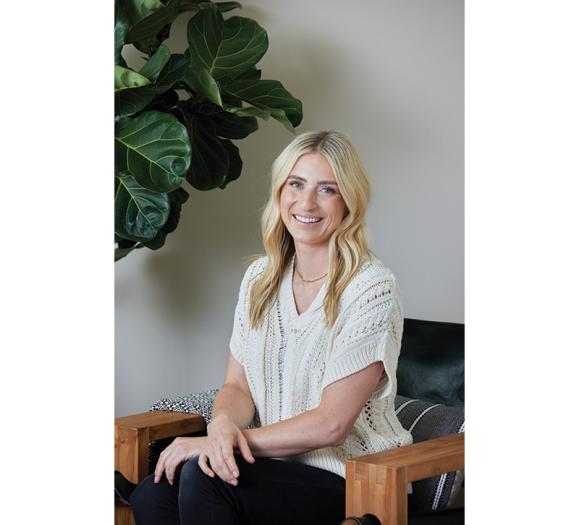Performance fabrics have come a long way. From being stain and sun-resistant to upping the comfort factor, performance fabrics have gone from strictly outdoor to the preferred textile for upholstery, particularly in families with children and pets. If you can wipe up a spill or throw your slipcovers in the laundry, the cleanliness, convenience and cost-savings make a difference.
However, textile makers are not resting on their laurels. Instead they continue to innovate and make performance fabrics better, safer and more sustainable.
We are in an era where sustainability as well as health and wellness in the home are of tantamount importance to the consumer, particularly younger generations, such as Gen Z. According to an Environmental & Energy Leader survey, consumer awareness of product sustainability has increased since 2021, indicating that it has become an expectation, not an exception. Of consumers surveyed, 84 percent say they’ve purchased a sustainable product in the past six months, up from 67 percent who reported the same in 2021. While sustainability has become more important in all consumer demographics, the latest push toward sustainability is coming from younger generations. Gen Z consumers are most tolerant of higher prices when deciding on a sustainable product purchase and more likely to buy them, according to this survey. Most (90 percent) of Gen Z consumers surveyed have bought a sustainable product in the past six months, compared with 78 percent of Baby Boomers. Overalll, consumers understand that sustainable products come with a higher price tag, and yet, eight percent more consumers said they would pay those prices between 2021 and 2022.
With performance fabrics, where consumers and their families are spending much of their time, reduced toxicity, awareness of where the textiles are made and recycling efforts are top of mind for sustainability.
Making Fabrics Safer
Last year, Crypton was a leader in the efforts to remove all flourine from its performance coatings, eliminating the last one percent with the removal of PFAS. As state regulations change around the use of these chemicals, Crypton was out in front, and now delivers a coating that continues to repel dirt and liquids as well as previous coatings. While the new fabrics don’t repel oil as well without PFAS, the cleanability of oil-based liquids has remained as effective.
Six months after launching this initiative, Crypton has had a good reaction. “We launched at a really good time,” says Lance Keziah, CEO. “Our customers have responded in a positive light. We were considerate about how we launched and we had proven the technology.”
In the last three months, Keziah continues, there has been increased awareness around PFAS-free. Having gotten ahead of the curve on the topic reinforces Crypton’s leadership position in the industry. Changing the formula took five years to perfect, and these chemicals needed to be removed from the plants where Crypton operates. Crypton is a global fabric supplier with mills in several countries, as well as in North Carolina. “We’ve done a great job managing that,” Keziah says. “Now our European and China operations are in the same space with these fabrics.”
While a leader in this sustainable endeavor, Crypton is not alone in its efforts to remove the last traces of fluorine from textiles. Milliken recently announced that its performance offerings are also now PFAS-free. As with Crypton, the company is transparent about the change in repelling oil — flourine is the only substance known to repel oil — but the sustainability and wellness factors outweigh that, since oil can still be cleaned. Millliken says that its new formulas without PFAS have shown equivalent, and in some cases, superior performance to its previous formulas. “This is a tremendous accomplishment and tribute to our team who worked around the clock to develop solutions that meet our customers’ performance requirements and reflect our purpose to positively impact the world for future generations,” says David Smith, EVP, Milliken and Co., and President, Milliken’s Textile Business.
Getting the Word Out
While creating more sustainable textiles is important, the bigger hurdle is helping customers, distributors and the consumer understand the value. “A lot of our customers understood what PFAS meant, a lot did not,” says Keziah. “We’ve done extensive training with our customers so they understand the technology.”
Elise Gabrielson, Vice President of Marketing for Crypton, adds, “We’ve made a group effort to educate manufacturers and our distributor partners about what [the new coating] is and what it does. We have a full team of product specialists, as we’re all about training at the retail level as well.”
“We were 99.9 percent flourine-free already. There was nothing in our technology or formulations that were harmful to the consumer. It was important to show delicacy in how we handled that messaging,” says Keziah, adding that this is better for the consumer now, so Crypton has spent its time working with its customers on how they explain changes.
Next Steps
PFAS removal is one step in the growing sustainability movement that’s happening in performance textiles. For Crypton, there are other initiatives as well, such as a recycling program and bringing more of its textile manufacture back to the U.S. as it continues to grow its capabilities at its North Carolina mill. While the company will always be global, and likely have global mills that it works with, bringing more manufacturing here is good for business. “There’s so much global turmoil,” Keziah notes. “As we invest more we in our weaving facility [in NC], it gives us a stronger foothold to continue to be the supplier we want to be.”
Glen Raven, parent company of the Sunbrella brand, recently released its corporate sustainability report, outlining initiatives the company is taking to continue to be a better steward of the environment. “Our 2022 corporate sustainability report highlights our ongoing commitment in our journey toward becoming a better corporate citizen and a better place to work,” Glen Raven CEO Leib Oehmig says in a statement. “Our approach to business growth remains grounded in integrity and our responsibility to champion sustainability, support our customers and help our communities thrive.” Some statistics from this report reveal Glen Raven’s recycling efforts, including that nearly 750,000 pounds of recycled raw materials were used to create Glen Raven products in 2022. In addition, due to the company’s zero-waste-to-landfills initiative across its global facilities, 97 percent of waste was diverted from landfills in 2022 via its operations.
Less toxicity. Recycling efforts. Bringing production closer to home. These efforts are not lost on the consumer, particularly those who are most concerned about the future of our environment. Consumers are willing to pay more for sustainability, and as long as their performance fabrics continue to perform, sustainability efforts will continue to improve the impact of performance fabric-making practices.







